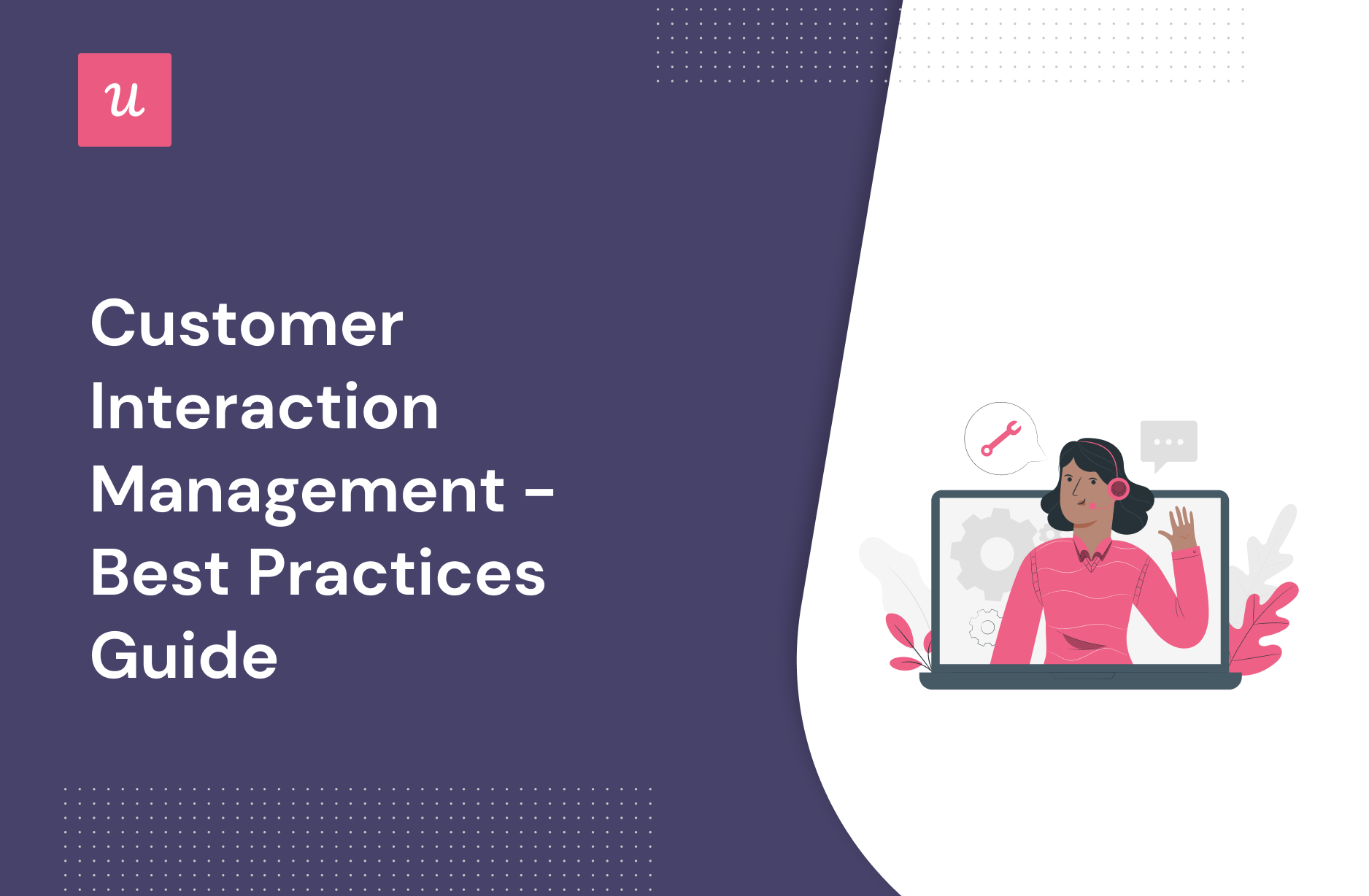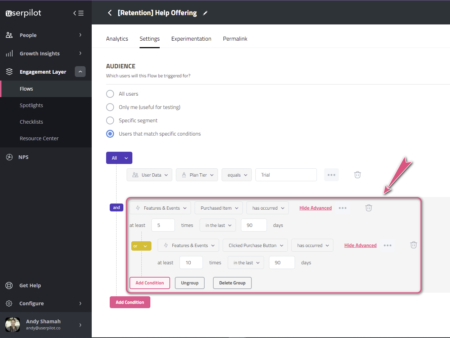
Get The Insights!
The fastest way to learn about Product Growth, Management & Trends.
What is customer interaction?
Customer interaction is exactly what it sounds like: every form of communication and engagement between a business and its customers.
Customer interactions can take the form of active human communications through social media, phone calls, and customer support channels. It can also be proactive through in-app chatbots and a company’s self-help resource center.
Customer interaction vs. customer experience
The customer experience sums up all customer impressions about your brand and product as they journey from pre-purchase to offboarding.
In comparison, customer interaction is more of a two-way street involving direct communication between the business and customer simultaneously. The company responds proactively or reactively to customer problems, to create a better customer experience.
How can positive customer interactions improve your business?
- Understand customer pain points and improve the user experience: By interacting with customers, you understand common pain points and provide ways to solve them for existing and potential customers.
- Reduce churn: Customers on the verge of churn can be motivated to continue doing business with you when they see that you truly care about them.
- Improve retention and brand loyalty: Positive interactions generally aim to satisfy customers. When this happens, you can be sure your customers will stick around for long.
- Increase referrals: There’s a direct correlation between customer satisfaction and referrals. Happy customers tend to always spread positive words about you.
Why is every customer interaction important?
Treat all customer interactions as opportunities to sell your brand.
You want to give your customers a reason to keep renewing their subscriptions. And listening to them is a good way to do that.
One bad experience with your brand is enough to make someone stop using your tool. It can get worse: your customers have friends and family that could be interested in your product. Imagine someone leaving your brand due to a negative interaction with one of your support agents. They will share the experience with people in their network, which will make you lose prospective customers.
But the opposite is also true. Investing in qualitative customer interactions will result in loyalty, referrals, and increased revenue.
What are the types of customer interaction?
Each type of customer interaction is unique and demands slightly different responses. Let’s go over them:
- Requests: These interactions involve customers asking for new features and functionalities. Let such customers know that you’ve received their requests and will get back to them.
- Questions: Customers that don’t understand how to get something done or are trying to figure out your tool will reach out with questions. Providing an in-app resource center with rich materials will enable these customers to solve most of their problems themselves.
- Complaints: All customer interactions are important, but complaints should be taken very seriously. Not every user that encounters friction will come complaining. Best believe the few who do represent a large chunk that will rather lag or churn than send complaints.
- Compliments: These interactions come from satisfied customers who reach out to praise your brand. Appreciate them for taking the time to compliment you. You could also encourage them to leave a review if they can.
How can customer interactions be categorized?
Categorizing customer interactions will give you proper context and enable you to create more satisfying experiences.
Customer interactions can be classified into three:
- Stabilizing: These interactions are aimed at boosting retention. They happen early in the customer journey and are meant to introduce users to the product. Stabilizing interactions are essential because new customers are most at risk of churn. They came to your tool with expectations and will immediately start seeking to reconcile those expectations with the product experiences they’re having. Customers may leave if their expectations don’t match the reality.
Stabilize your customer relationships and make users realize the different ways they can further interact with your tool and get help when they need it.
- Critical: Critical interactions are unusual and produce peak emotions—positive or negative, depending on how the company responded. Critical interactions aren’t common, but the more time a customer spends with your tool, the more likely they are to encounter them. Customer service teams should be trained to respond appropriately to customers during critical interactions.
- Planned: These interactions are intentional and meant to create account expansion through upselling or cross-selling. They can be initiated by sales or customer success teams or automatically triggered based on product usage and specific user interactions.
For example, Loom sends contextual messages when the user has reached the recording limit on their free account, reminding them about the limitations and prompting upgrades.

How should you interact with customers?
Customer interaction channels are ever-increasing. Gone are the days when business-customer communication was restricted to emails and phone calls.
Customers expect convenient, instant, and seamless communications where they are.
Here are five ways you can automate interactions and still keep the personal communication level your customers expect from your brand.
Proactively interact with customers with self-service resources
If you had to choose between filling out customer service forms/chatting with an agent and resolving your issues on your own, which would you choose?
Most people prefer to sort things out alone, provided they have the necessary information.
This is where self-help resource centers come in.
Customer interactions don’t always have to be initiated by the customer. Anticipate user needs and create a combination of self-help resources such as product documentation, FAQs, video tutorials, etc., which they can turn to when they need.

Engage with customers through in-app messages
In-app communication is contextual and should be your preferred way of delivering important info to customers.
You can use in-app messages to onboard new users, drive feature adoption, account expansion, collect user sentiment, etc. The best part is that you can segment your users and trigger messages accordingly.
Onboard and engage mobile app users by creating personalized messaging, push notifications, and surveys with Userpilot’s new native mobile SDK.
There are different types of in-app messaging you can use, including modals, banners, tooltips, checklists, interactive walkthroughs, and micro surveys to collect feedback.

Interact with customers via email
Email is also another channel of communication, especially for interacting with customers who don’t log into the app often to see your in-product messages.
Email communication can be used during onboarding to remind inactive customers about your product, announce major updates, or send them feedback surveys.

Get in touch with customers on social media
Social media is another place your customer base hangs out, so it makes sense to interact with them there.
You can answer customer questions and comments on social media, create polls, etc. Social media is also a good channel for new feature announcements. Here’s an example from Surfer.

Automate repetitive customer interactions with chatbots
Chatbots are a form of customer service automation that helps to reduce the hold-on time and improve customer interaction. They’re great for answering repetitive and low-effort questions or redirecting customers to relevant resources.

Stages of a customer interaction cycle
The customer interaction cycle corresponds to the customer journey stages. The cycle includes awareness, consideration, acquisition, retention, and loyalty.
- Awareness: The prospect is problem aware, but they don’t know about your brand yet.
- Consideration: They start searching for a solution and come across your brand. Prospects at this stage are matching you against competitors to know which will provide the best value for money.
- Acquisition: They have become users of your brand but are still exploring your product and haven’t made a long-term decision.
- Retention: Every company should aim at retaining a good chunk of acquired users because that’s the only way to build a successful business. This can be achieved by ensuring maximum customer satisfaction and being the brand that listens to its customers.
- Loyalty: Done well, your retention strategies will turn many into loyal customers. These die-hard advocates of your brand will continue using your product and refer others when they can.

Most common scenarios of customer interactions and how to handle them
Understanding customer interaction scenarios will prepare you to respond accordingly, creating the best possible experience. This section shows you the most common interaction scenarios and how to respond.
Potential customers looking for information
These customers are in the awareness stage. They’ll find your tool through ads, social media content, or blog posts. Some may be interested in reaching out to your customer service team to learn more about the product. But many of them wouldn’t.
Your focus at this stage should be on creating top-of-the-funnel content that educates and further guides them down the journey.
Customers comparing different solutions
A proof that customers have journeyed beyond the awareness stage is that they begin comparing different brands.
The best content to put out in this stage includes case studies, comparison pages, customer reviews, and other middle of the funnel (MOFU) content. These content pieces will build trust and authority, letting the customers know they can take you for a spin.

Customers during the onboarding stage
Customer onboarding interactions should introduce your product to new users and help them learn how to use it.
Use a combination of UI elements like tooltips, interactive walkthroughs, checklists, etc., to facilitate customer education.
Here’s an interactive walkthrough in action. Notice how it guides users step by step through engaging with a feature for the first time.

Customers who need assistance when using the product
Customers may often encounter situations where they’re confused about how to use a particular feature or simply can’t figure out how to get their job done.
Of course, you can contact and help them, but humans hate waiting. It would be better to direct them to engaging video or text tutorials where they’ll find what they’re looking for.

Unhappy customers who are at risk of churn
No matter how much effort you put into the customer experience, some people may still find reasons to churn.
But you can proactively avoid churn by following up with customers that give you a bad NPS/CSAT score. Ask personalized questions to understand their situation and offer help.

Loyal customers who can become brand evangelists
Keep an eye open for loyal customers and offer rewards that can potentially turn them into brand ambassadors. Your reward could be discounts or special offers; whatever you think the customer will find valuable.

How to facilitate positive customer interactions
Customer interactions can either be positive or negative. This section shows you the keys to having more positives than negatives.
Deliver proactive customer service with an on-demand resource center
Proactive support is about anticipating customer needs and creating solutions before the customer asks for them.
This will save time and reduce customer frustrations. You can deliver proactive customer service with an in-app resource center consisting of multiple formats. Also, add the option to contact customer support agents for people that may need it.

Provide personalized experiences
Personalization is the key to successful customer communication. Use tools like Userpilot to segment users and trigger experiences based on their journey stages and product usage or specific interactions.
Provide meaningful interactions through UI feedback
UI feedback refers to how your product responds to different user interactions. It sets customer expectations, removes friction, and improves user interaction.
An example of UI feedback is the loading page that shows up when the app is loaded. It’s the way the product tells users that something is happening in the background. A good loading page design will keep the user glued to that page, waiting for it to finish loading. They won’t think the app is broken and leave.

Collect customer feedback and close the loop
Collecting customer feedback at every touchpoint will give you valuable insights and help you discover customer pain points.
You can start with NPS surveys. Don’t forget to add follow-up, open-ended questions to your quantitative NPS question. Something like this:

Then analyze user sentiment data to identify patterns associated with low customer satisfaction and fix the issues.

Map out the customer journey and optimize the processes
Analyze all the stages your customers go through, from awareness to churn. Aim to identify roadblocks along the way and things you can do to provide customers with smoother interactions.
You can use tools like Miro to visualize the entire journey.

Conclusion
Customer interactions occur at every point of the buyer’s journey. Your goal as a company is to ensure customers get nothing short of the best possible experiences.
Do this by creating inbound content—especially to educate and capture prospects—and in-app messaging to guide users properly. Resource centers, good UI designs, and an efficient customer support system are also things you can add.
Searching for a customer interaction software? Userpilot is here to help. Book a demo call with our team to see how you can start making your customers happier.








